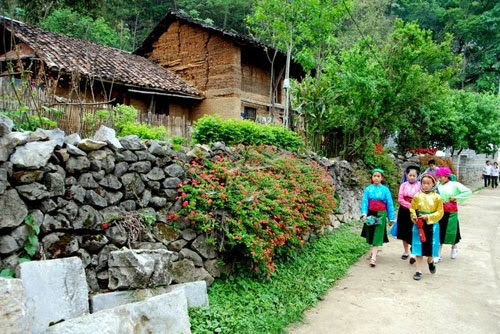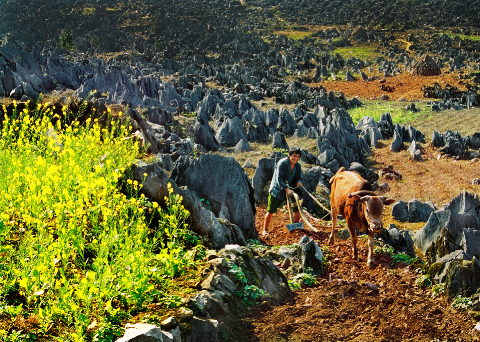As the home to 17 ethnic groups with unique traditions
and festivals, Dong Van Karst Plateau is believed to be good potential for
tourism development.
The Vietnam National Administration of Tourism (VNAT) has made a survey
in the districts of Quan Ba, Yen Minh, Dong Van, Meo Vac and discussed with Ha Giang province authorities on developing
tourism in this province. Accordingly, the global geological park of Dong Van
Karst Plateau will be built into a national tourism site.
Dong Van Karst Plateau Global Geopark joined the Global Geopark Network
on October 3, 2010. Its administrative area covers 2,356 sq. kilometers in four
districts of Quan Ba, Yen Minh, Dong Van and Meo Vac. The plateau features
geological heritage, cultural heritage and biodiversity.
In their initial assessments, scientists have investigated and identified
139 geological heritages, including 15 international geological heritages, 68
national geological heritages and 56 local geological heritages dating back
about 541 million years.
The plateau witnesses many important regional and global geological
events, especially two out of five major life-world extinction events that
caused the disappearance of 90 percent of marine genera and species, even
paleontology.
Dong Van Karst Plateau is inhabited by 17 ethnic groups with rich
traditional ethnic cultures, histories, customs and festivals. One of their
particular characteristics is their adaptability and harmony with the nature in
labour, as well as social and cultural activities.
The clearest expression is the planting of food crops in rock holes - the
most popular and special initiative of ethnic groups on the rock plateau.
Filling rock holes with earth to plant crops has become a unique culture and
agricultural civilization rarely seen in any other places in the world.
Dong Van Karst Plateau is also a unique biodiversity hotspot, consisting
of Bat Dai Son Nature Reserve, part of Du Gia Nature Conservation Park, and
Khau Ca Species and Habitat Conservation Area.
Therefore, the geopark has very rich flora and fauna systems, comprising
289 species of vascular plants belonging to 83 families. The fauna system on
limestone mountains has 171 species belonging to 73 families and 24 orders. 27
species, including 17 species of mammals, two species of birds and eight
species of reptiles, are endangered animals listed in the Red Book of Vietnam.
Especially, the Tonkin snub-nosed monkey species (Rhinopithecus
avunculus) is one of five endemic primate species in Vietnam and one of the
world's 25 most endangered primates. Besides, the plateau also has bare rocky
mountain ecosystems, regenerating forest ecosystems, and ground mountain
ecosystems. Although they do not have as rich biodiversity as natural
conservation areas, they significantly contribute to the biodiversity of the
geopark.
"Developing tourism in Ha Giang must be very careful, otherwise we
will have to pay highly for the lost of the priceless gifts of nature,"
says VNAT chief Nguyen Van Tuan. Last year 400,000 tourists went to Ha Giang.



















.jpg)
.jpg)
